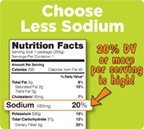September 2012 It's Our One-Year Anniversary!This issue marks the one-year anniversary of CFSAN's News for Educators — the at-a-glance bi-monthly e-news from FDA's Center for Food Safety and Applied Nutrition. Read on for quick, basic food safety tips to promote during National Food Safety Education Month and all year long, as well as exciting news about FDA's new online sodium materials and an important update on tattoo safety. Don't miss the list of upcoming meetings and events from FDA! We invite you to share this newsletter. Invite your colleagues to sign up for future issues! |

 National Food Safety National Food Safety
Education Month
September is National Food Safety Education Month. As an educator, you can help consumers understand the potential impact of foodborne illness on them and those they care about. According to CDC, roughly 1 in 6 Americans (48 million people) gets sick, 128,000 are hospitalized, and 3,000 die of foodborne diseases each year. So when working with consumers, it's critical to reinforce the Four Simple Steps to Food Safety — in the cafeteria, at home, or wherever else meals are prepared or enjoyed!: Clean: Wash hands, utensils and surfaces often Separate: Separate raw meats from other foods Cook: Cook to the right temperatures using a food thermometer Chill: Refrigerate foods promptly
Online Resource: September represents "back to school" across the country, too. That means it's a great time to get students involved in practicing good food safety behaviors! Check out FDA's Science and Our Food Supply — a FREE supplementary curriculum for middle and high school students. And for engaging materials to help you teach families about food safety, don't miss the Partnership for Food Safety Education's Myth Busters Education Kit, featuring online quizzes and activities. |

 New Sodium Materials Are Online! New Sodium Materials Are Online!
Did you know? Over 75% of dietary sodium comes from eating packaged and restaurant foods. Most Americans eat too much sodium, and sodium has been linked to high blood pressure, which can increase the risk of heart disease, kidney disease, and stroke. Remind consumers that the Nutrition Facts Label is a handy tool they can use every day to get less sodium through smart dietary choices. Understand Percent Daily Value (%DV) for sodium. The %DV for sodium is based on 100% of the recommended amount of sodium — which is less than 2400 milligrams (mg) per day. Read the Label when comparing products. %5 DV or less of so in one serving is low; 20% DV or more is high. Choose the lower sodium option!dium Ask for nutrition information at restaurants. Choose menu items containing less sodium.
Online Resource: Invite consumers to check out FDA's "Sodium: Look at the Label" materials. The handy fact sheet and infographic provide the basic info needed to monitor daily intake of dietary sodium. |

 Tattoos: Important Info About Tattoos: Important Info About
Contaminated Ink
Tattoos are a trend that can be seen among consumers of all ages: from young people following this continuing fad to adults considering their first — or perhaps most recent — body art. But FDA is concerned about a family of bacteria called nontuberculous Mycobacteria (NTM) that has been found in a recent outbreak of illnesses linked to contaminated tattoo inks. You can alert consumers about these facts and safety measures: One type of NTM, M. chelonae, can cause lung disease, joint infection, eye problems and other organ infections. NTM infections may look similar to allergic reactions — so they are easily misdiagnosed. The ointments often provided at tattoo parlors don't treat these infections. Consumers should contact a health care professional if they see a red rash with swelling, possibly accompanied by itching or pain in the tattooed area, usually appearing 2-3 weeks after tattooing. In addition, if a consumer suspects a tattoo-related infection, FDA asks that he/she report the problem to the tattoo artist and to MedWatch online or at 1-800-332-1088, or contact the FDA consumer complaint coordinator in your state. This can help prevent others from becoming infected.
Online Resource:Provide consumers of all ages with need-to-know information about the risks of contaminated tattoo ink and the steps FDA is taking to control risks of infection
For More Information |
| Upcoming Events
Academy of Nutrition & Dietetics (ADA) Conference
October 6–9, 2012
Philadelphia, PA
American Academy of Family Physicians
October 17–20, 2012
Philadelphia, PA
National Science Teachers Association Regional Conference
October 18–20, 2012
Louisville, KY
American Public Health Association Annual Conference
October 27–31, 2012
San Francisco, CA
National Association of Biology Teachers Conference
October 31– November 3, 2012
Dallas, TX
National Science Teachers Association Regional Conference
November 1–3, 2012
Atlanta, GA
Association of Middle Level Education Conference
November 8–10, 2012
Portland, OR
National Science Teachers Association Regional Conference
December 6–8, 2012
Phoenix, AZ |







 National Food Safety
National Food Safety  New Sodium Materials Are Online!
New Sodium Materials Are Online!  Tattoos: Important Info About
Tattoos: Important Info About 

